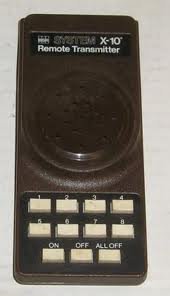X10
As the oldest protocol on the market X10 has build up quite some reputation over the last 30 years.
Communication
Powerline/Wireless
X10 was originally designed for powerline communication only but through time the need for wireless communication emerged.
Benefits of the X10 Protocol
- Cheap
- Available almost everywhere (RadioShack)
- Big community and existing inspirations due to its age
Disadvantages of the X10 Protocol
- Slow
- Unreliable (newer Powerlines have become very noisy causing the loss of commands)
- No Encryption
- Difficult to install for non-techies compared to newer technology (e.g. Z-Wave, ZigBee)
History of X10
The X10 protocol was invented in 1975 by Pico Electronics in Glenrothes, Scotland.
The name X10 derives from the fact that this home automation protocol was simply the tenth project of Pico Electronics.
Before this groundbreaking invention the company was already known for revolutionizing the calculator industry with its first single chips for calculators in 1970. Nowadays this doesn’t seem like much but in the seventies your average calculator used no less than 5 chips. This single chip design is also known as an Integrated Circuit (IC) or microchip. They even claim that this was the world’s first microprocessor although this hasn’t been officially confirmed yet. But as with all technological advancements sooner or later they will become a commodity and when the prices for calculator ICs began to drop Pico decided that they need to develop their own commercial product and not just parts for other manufacturers. They were looking for a joint venture preferably in the United Kingdom and relatively quickly found a new partner with Birmingham Sound Reproducers (BSR) in 1974. BSR was the world’s biggest fabricator of record changers at the time. Record changers would select tracks on a regular vinyl. The new product was named “Accutrac 4000” (nowadays also known as ADC Accutrac 4000) and internally named X9, since it was the ninth invention of Pico Electronics after eight previous integrated circuit projects. Pico developed a remote control for the Accutrac using ultrasonic signals which made it possible to change the tracks while sitting on the couch. This was a pretty rare feature in the mid-seventies. Here is a youtube video demonstrating the remote control (look at the comments of some of the vintage lovers to realize the big technological advancement of this gadget):
Pico thought: “If we can control the track selection remotely, why not control the lights and appliances while we are at it?”. The idea for transmitting signals over existing electrical wiring was born and with it the company’s tenth project, hence X10. Pico refined the technology over the upcoming years and in 1978 the first X10 components started to appear in Radio Shack stores. Radio Shack was already a very large electronic retailer with stores scattered all over the United States which helped to make the X10 technology known to tech savvy users. The appearance in Sears stores which were not only limited to technology equipment increased the popularity of this technology even further. Out of the joint venture with BSR a new company called X10 Ltd. had been formed and shortly after the first product called the “BSR System X10” saw the light of the consumer market. Below you can see a picture showing its three components : the 16 channel command console, the lamp module, and the appliance module.


Trivia
What most people don’t know is that X10 was a pretty heavy advertiser in 2000/2001 when the Internet was slowly becoming popular amongst non-tech-savvy users. Their ads were literally everywhere. Unfortunately they didn’t showcase their awesome technology but tried to acquire new customers by advertising little wireless cams to spy on women in short skirts. Instead of aiming at the average geek they were targeting voyeurs. It was a strange time back then. X10’s ads reached 32% percent of all Internet users and the X10 website was the 4th most trafficked website at that time. See two examples of these hilarious ads below. I personally love the Comic-Sans Yellow-Blue-Red demon. Luckily, the Internet has definitely matured during the last decade.


Sources
- https://www.smarthomeusa.com/info/x10story#story
- http://home.planet.nl/~lhendrix/x10_history.htm





